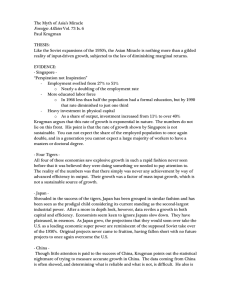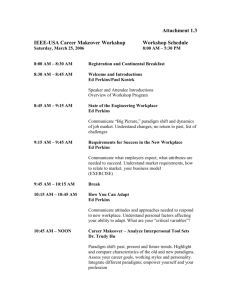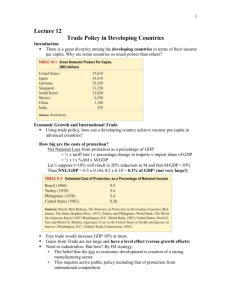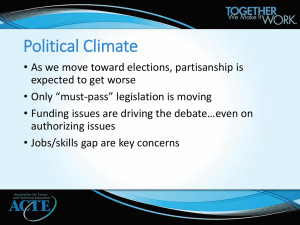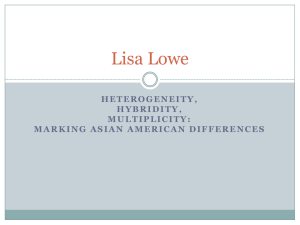Document
advertisement
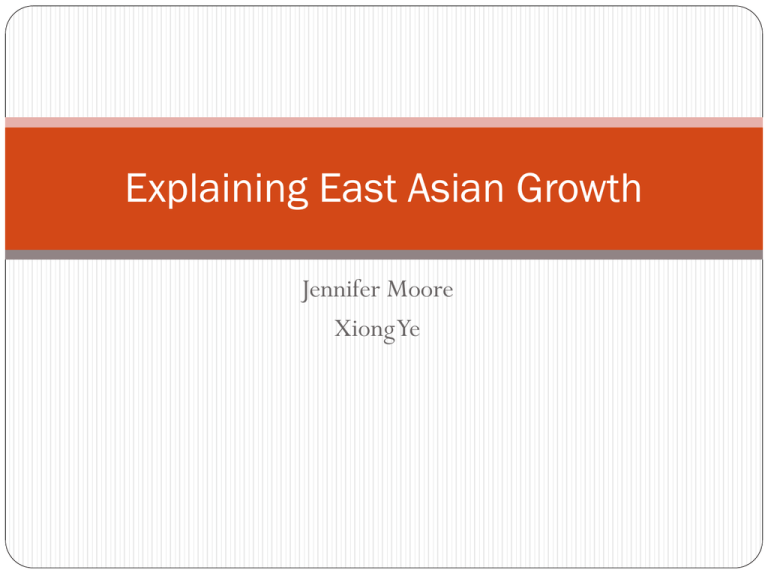
Explaining East Asian Growth Jennifer Moore Xiong Ye There Are At Least Three Models of East Asian Development Dwight H. Perkins World Bank Study of The Success of High Performing Asian Economies 1. the emphasis on the export of manufactures 2. the maintenance of macroeconomic stability 3. the emphasis on primary and secondary rather than tertiary education At Least Three Distinctive Models 1. Manufactured export-led state interventionist model: Japan, Korea, and Taiwan 2. Commerce dominated model: Singapore and Hong Kong 3. Rich in natural resources but not in human resources: Indonesia, Malaysia, and Thailand 1. The emphasis on the export of manufactures World Bank Perkins The concentrated effort to Manufacture exports for promote manufactured exports was critical. Malaysia and Indonesia, because of the exportable natural resources, are not the same as other East Asian economies. 2. The maintenance of macroeconomic stability World Bank Perkins HPAEs respected fiscal It is not that the HPAEs all prudence and avoided overvalued exchange rates. managed to maintain balanced budgets and limit their borrowing abroad. HPAEs, on average, budget deficits were as large as other developing countries. Indonesia borrowed heavily abroad. 3. Emphasis on primary and secondary rather than tertiary education World Bank Perkins HPAEs emphasized on Agreed on, and human capital development complemented most parts of by providing universal the study. primary education and Quarrel: WB was too casually expanding secondary lumping together different education. human capital development challenges that faced to Muslim dominated counties versus Confucian value system dominated countries. The Role of Government Interventions World Bank Perkins Attempts to both describe The diversity is enormous the diversity and draw general conclusions applicable to all or most. and making a coherent story out a that diversity is a formidable task. The Historical And Political Context World Bank Perkins Explained what the HPAEs Should give more attention did to achieve rapid growth. to “why” HPAEs were able to carry out effective policies The Myth of Asia’s Miracle Paul Krugman - Soviet Expansion Initial success of a centrally planned economy (CPE) Alarmed the U.S. and other Western nations “The rapid growth in output could be fully explained by rapid growth in inputs:” Employment Education Investment in physical capital - Four Tigers Input-driven growth Lack of technical progress - Singapore Employment swelled from 27% to 51% Nearly a doubling of the employment rate More educated labor force In 1966 less than half the population had a formal education, but by 1990 two-thirds boasted a formal education Heavy investment in physical capital As a share of output, investment increased from 11% to over 40% Contributions of the Sources of Growth (percentage) Country Capital Labour Technical Progress China 92.2 9.2 -1.4 Hong Kong 55.8 16.0 28.2 Indonesia 115.7 11.5 -27.2 Japan 62.9 4.7 32.4 Malaysia 70.9 18.7 10.5 Philippines 99.5 22.6 -17.5 Singapore 60.0 20.9 20.1 South Korea 86.3 12.7 1.0 Taiwan 88.9 8.6 2.5 Thailand 71.9 12.7 15.3 France 37.8 -1.3 63.5 West Germany 43.7 -6.3 62.6 United Kingdom 46.0 3.7 50.3 United States 32.9 26.2 41.0 APCs IWCs - China & Japan Issues with China Statistical reliability and biased data A threshold comparison timeframe Japan as an outlier Exhibited heavy input-driven growth Marked with expanding efficiency Aligns more with western nations Has hit a plateau - Conclusion Perkins: World Bank study is seen as part of an ongoing attempt to explains East Asians economies, but there is still a great deal of work needs to be done. Krugman: Like the Soviet expansions of the 1950’s, the Asian Miracle is nothing more than a gilded reality of input-driven growth. Sources: Kim, J., & Lau, L. J. (1996). The sources of Asian Pacific economic growth. Canadian Journal of Economics, 29(2), S448. Krugman, P. (1994). The Myth of Asia’s Miracle. Foreign Affairs, 73(6), 62-78. Perkins, D. (1994). “There Are at least Three Models of East Asian Development,” World Development 22(4): 655-661. World Bank (1993). The East Asian Miracle: Economic Growth and Public Policy.
